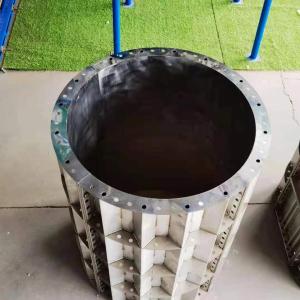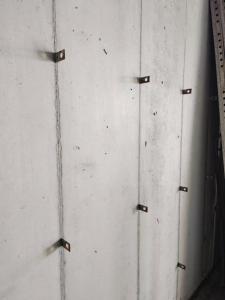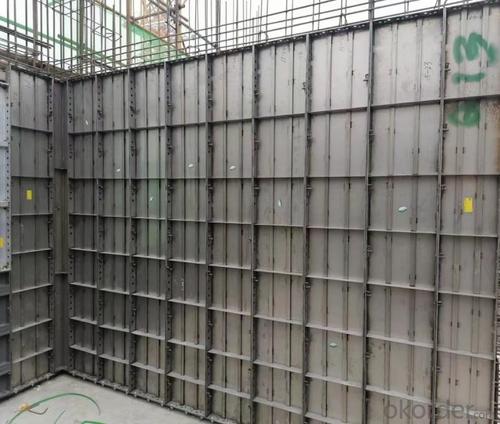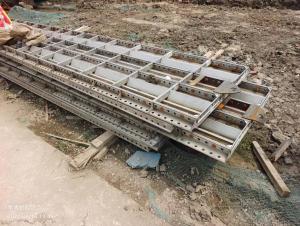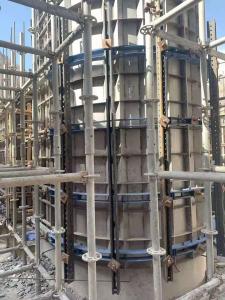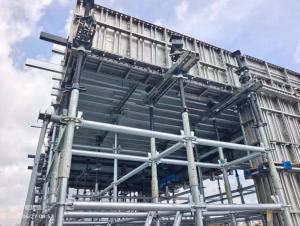Hot seller-steel formwork for concrete,concrete column formwork , Stainless Steel Formwork
- Loading Port:
- Shanghai
- Payment Terms:
- TT or LC
- Min Order Qty:
- 1 set
- Supply Capability:
- 1000000 set/month
OKorder Service Pledge
OKorder Financial Service
You Might Also Like
Stainless steel formwork
Replaceable size aluminum formwork :400X1200mm , 400X1500mm
PRODUCT CHARACTERISTICS
Stainless steel side profiles
80kn/M2 maximum pressure
3 different heights; 1.2m, 2.7m and 3.3m
suitable to be used on any site where circular walls need to be poured. Adjusting the radii is easy and simple, making Conflex a cost-effective system.
Advantages:
1 Stainless steel formwork, 100% follow the design of aluminum alloy formwork system, it is interchangeable, compatible and can be used together with aluminum formwork at the same time .
2It is made of high-strength stainless steel strip by rolling and laser welding. It has good corrosion resistance and high density,is not easy to rust and has no fire hazard.
3Long service life, many turnover times, high recycling value
The number of turnovers is large, especially the characteristics of no dust, no need to brush or less mold release agent, and the characteristics of low renovation costs will bring unlimited optimistic prospects to it.
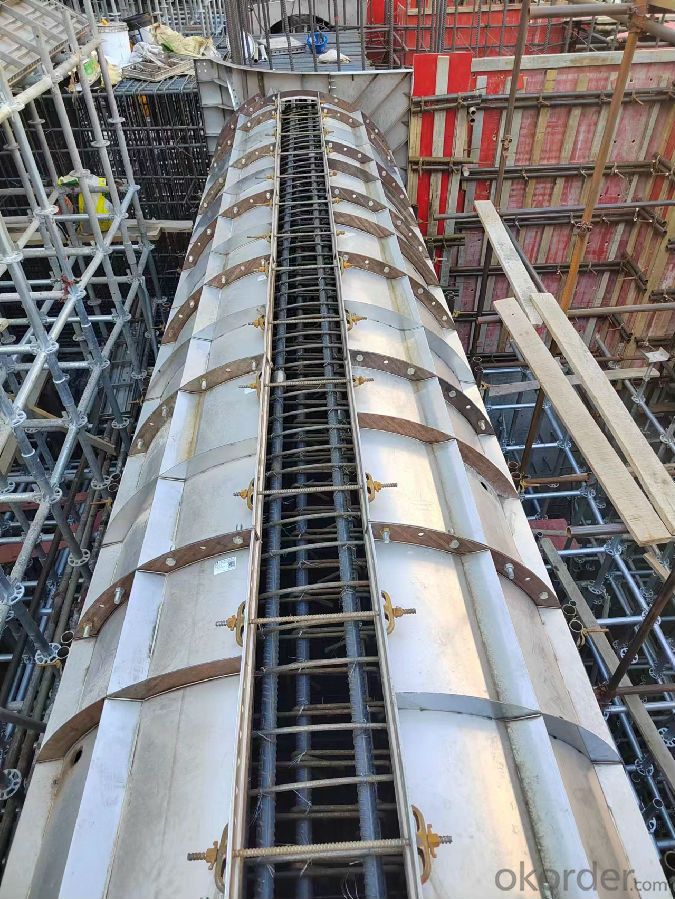
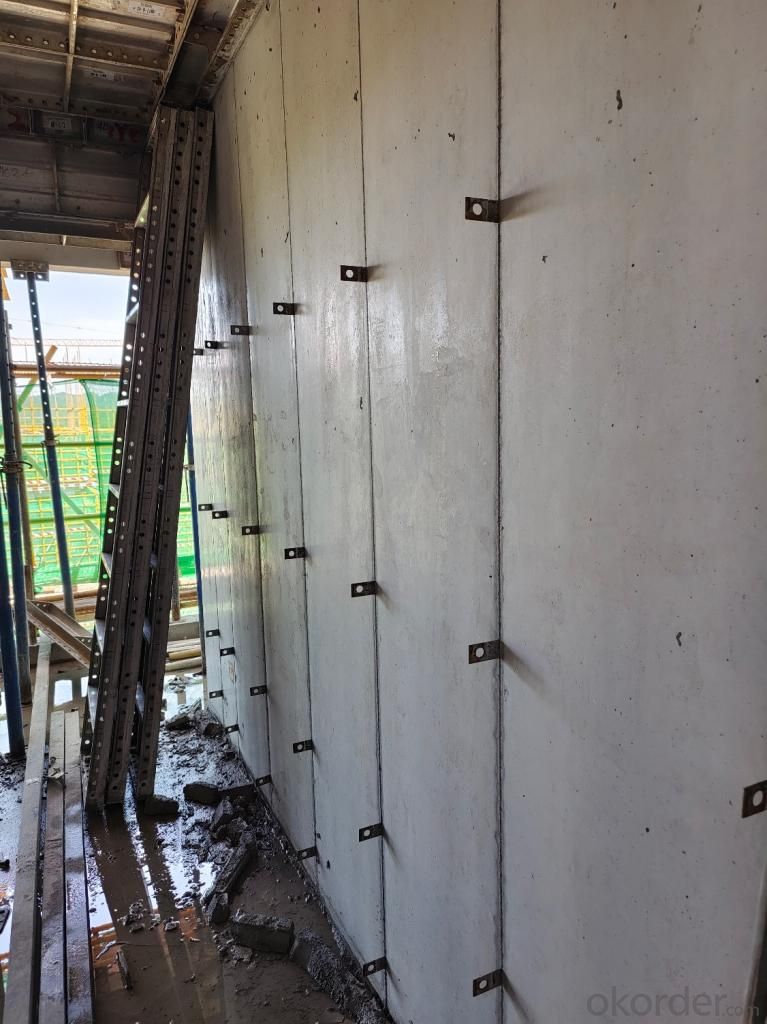
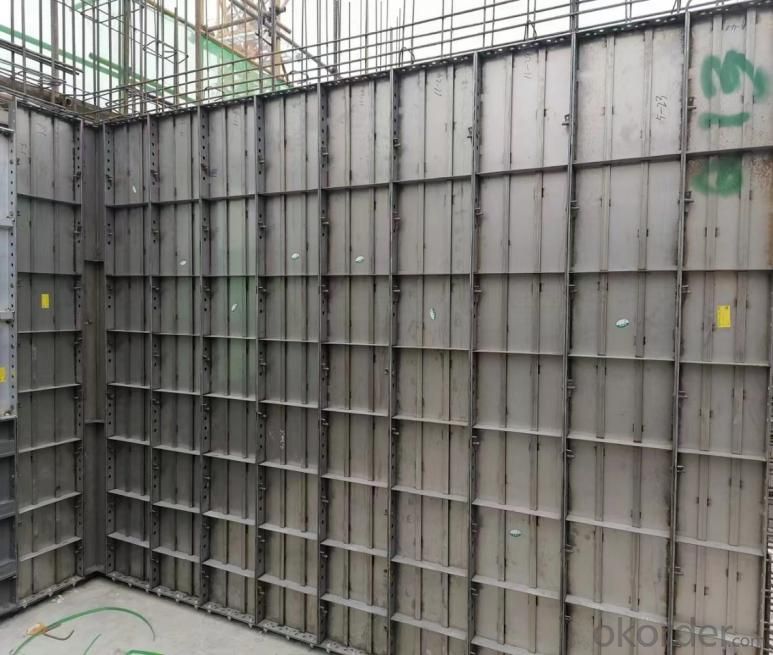
- Q: How does steel formwork handle formwork stripping and repositioning?
- Steel formwork is well-suited for handling formwork stripping and repositioning due to its inherent strength and durability. With steel formwork, the process of removing the formwork from the concrete structure is relatively easy and efficient. The steel panels or frames can be quickly detached and repositioned at the desired location, allowing for seamless reusability and adaptability. This flexibility and ease of handling make steel formwork a preferred choice for projects that require frequent formwork stripping and repositioning.
- Q: How does steel formwork affect the overall strength of the structure?
- The overall strength of a structure can be greatly enhanced by steel formwork. Steel, known for its exceptional strength and durability, is an ideal material for formwork. When used in construction, steel formwork creates a rigid framework that bears the weight of the concrete during pouring and curing. The utilization of steel formwork guarantees proper containment and support for the concrete, preventing any deformation or collapse during the hardening phase. This is essential for maintaining the structural integrity of the building, as any failure in the formwork can have serious consequences. Additionally, steel formwork offers greater design flexibility as it can be easily customized and shaped to fit the desired structure. This versatility empowers engineers and architects to create intricate and innovative designs without compromising the building's strength. Furthermore, steel formwork has a longer lifespan compared to other formwork materials like wood or plastic. Its durability allows for multiple reuses, reducing construction costs and minimizing waste. This not only makes it cost-effective but also contributes to sustainability in the construction industry. In conclusion, steel formwork positively impacts the overall strength of a structure by providing a robust and reliable support system for the concrete. Its strength, durability, and flexibility make it an excellent choice for ensuring the structural integrity and longevity of buildings.
- Q: What are the different types of finishes applied to steel formwork surfaces?
- Steel formwork surfaces can be enhanced with various finishes, each serving a specific purpose. These finishes aim to improve the appearance, durability, and performance of the steel formwork. Here are some commonly used finishes: 1. Galvanized Finish: A popular choice for outdoor or high-moisture environments, this finish involves coating the steel with a layer of zinc, offering excellent corrosion resistance. 2. Powder Coating: In this process, a dry powder is electrostatically applied to the steel surface and then cured under heat. The result is a hard, long-lasting finish that resists chipping, scratching, and fading. Powder coatings come in a wide range of colors and textures. 3. Paint Finish: Paint finishes are commonly used to enhance the aesthetics of steel formwork. They provide a smooth, uniform appearance and can be customized to match specific color requirements. Paint finishes also offer some protection against corrosion and weathering. 4. Epoxy Coating: Known for their chemical resistance and durability, epoxy coatings are often used in industrial applications where the steel formwork may be exposed to chemicals, acids, or solvents. These coatings also provide good adhesion and resistance to abrasion. 5. Anodized Finish: The anodizing process forms a layer of aluminum oxide on the steel formwork surface, resulting in enhanced corrosion resistance and a decorative appearance. Anodized finishes are commonly used in architectural applications. 6. Stainless Steel Finish: In certain steel formwork applications, a stainless steel finish may be preferred. Stainless steel is naturally resistant to corrosion and has a sleek, modern appearance. It is often used in environments with high humidity or chemical exposure. These examples highlight the different finishes available for steel formwork surfaces. The choice of finish depends on factors such as the formwork's intended use, desired aesthetics, and environmental conditions it will face.
- Q: How do steel formwork systems differ from one another?
- Steel formwork systems can differ from one another in several ways. Firstly, they can vary in terms of their design and construction. Some steel formwork systems are modular, meaning they consist of pre-assembled panels that can be easily connected and adjusted to form different shapes and sizes. Others may be custom-made for specific projects, offering more flexibility in terms of formwork design. Secondly, steel formwork systems can differ in terms of their strength and durability. Some systems are designed to withstand heavy loads and extreme conditions, making them suitable for large-scale construction projects. Others may be lighter and more portable, making them ideal for smaller projects or areas with limited access. Another factor that distinguishes steel formwork systems is their ease of use. Some systems are designed to be user-friendly, with features such as built-in handles, adjustable brackets, and easy-to-use locking mechanisms. These systems allow for quick and efficient installation and dismantling, saving time and effort on the construction site. Additionally, steel formwork systems can differ in terms of their finishing options. Some systems offer smooth and precise finishes, ideal for projects that require a high-quality surface. Others may have textured or patterned finishes, providing a decorative element to the concrete structure. Lastly, steel formwork systems can differ in terms of their cost and availability. Some systems may be more affordable and readily available, making them a popular choice for smaller projects or budget-conscious contractors. Other systems may be more expensive or require longer lead times for fabrication, but offer advanced features or customization options. Overall, the differences between steel formwork systems lie in their design, strength, ease of use, finishing options, and cost. Contractors and construction professionals should carefully evaluate these factors to select the most suitable steel formwork system for their specific project requirements.
- Q: What are the safety considerations when working with steel formwork?
- To ensure the workers' well-being and the project's success, it is important to consider several safety factors when working with steel formwork. The foremost priority is to provide comprehensive training to all workers involved in handling and installing steel formwork. This training should cover safe handling techniques for heavy steel panels and proper assembly and dismantling procedures. Additionally, workers should be educated on the potential risks associated with steel formwork, such as falling objects and pinch points, and how to mitigate these risks. Another crucial safety consideration is the use of appropriate personal protective equipment (PPE). It is necessary to supply workers with and enforce the use of PPE such as hard hats, safety glasses, steel-toed boots, and gloves to safeguard against potential hazards. It is also essential to ensure that the PPE is in good condition and properly fitted for each worker. Maintaining safety on a steel formwork site relies heavily on proper planning and organization. This entails conducting thorough risk assessments, identifying potential hazards, and implementing control measures to minimize risks. Establishing designated walkways and clear access routes is vital to prevent tripping hazards and ensure safe movement around the site. Regular inspections of the steel formwork system are necessary to identify any signs of damage or deterioration. Prompt repair or replacement of any damaged or defective components is crucial to maintain the formwork's structural integrity and safety. Finally, effective communication and coordination among workers are essential for a safe working environment. It is important to establish clear communication channels and procedures to ensure that everyone is informed about potential hazards and can promptly report any safety concerns. By prioritizing training, providing proper PPE, planning and organizing the work site, conducting regular inspections, and promoting effective communication, the safety considerations when working with steel formwork can be effectively addressed, reducing the risk of accidents and injuries.
- Q: How does steel formwork contribute to the overall sustainability of the project?
- There are several ways in which steel formwork contributes to the overall sustainability of a project. Firstly, steel is an incredibly durable material that can withstand heavy loads and repeated use. This means that the same steel formwork can be used for multiple construction cycles, reducing the need for new formwork materials and minimizing waste. Moreover, steel formwork is highly adaptable and can easily be customized to meet various design requirements. This flexibility allows for efficient material usage and reduces the amount of construction waste generated. Furthermore, steel formwork is highly recyclable. When it reaches the end of its life cycle, it can be easily taken apart and recycled. This reduces the demand for new steel production and minimizes the environmental impact associated with mining and manufacturing new materials. Additionally, compared to traditional timber formwork, steel formwork offers better quality control. It provides precise and consistent dimensions, resulting in a final product of high accuracy and quality. This reduces the need for rework and ensures less material wastage. Lastly, the use of steel formwork can lead to shorter construction periods. Its quick assembly and disassembly allow for faster construction processes, reducing the overall energy consumption and carbon emissions associated with the project. To conclude, steel formwork contributes to the overall sustainability of a project through its durability, recyclability, versatility, and efficiency. By reducing waste, minimizing environmental impact, and improving construction processes, steel formwork helps create more sustainable and environmentally-friendly construction projects.
- Q: How does steel formwork affect the overall cost-effectiveness of a construction project?
- There are several ways in which a construction project can benefit from the use of steel formwork, making it a cost-effective choice. Firstly, steel formwork is incredibly durable and can be reused multiple times without experiencing significant wear and tear. This means that there is no need for frequent replacements, resulting in cost savings in terms of materials. Furthermore, steel formwork provides excellent dimensional stability, ensuring precise and accurate construction. This eliminates the need for excessive adjustments and rework, saving both time and money. Additionally, the smooth surface finish provided by steel formwork reduces the need for additional plastering or finishing, further reducing construction costs. Moreover, steel formwork is known for its strength and load-bearing capacity. This allows for larger spans and fewer support beams, reducing the amount of materials required and consequently lowering costs. The structural integrity and stability of steel formwork also contribute to a reduction in the number of labor hours required for installation and dismantling, resulting in labor cost savings. In terms of time efficiency, steel formwork offers quicker assembly and disassembly compared to traditional formwork systems. This can significantly reduce construction durations, leading to cost savings associated with labor, equipment rental, and overhead expenses. Additionally, steel formwork is highly adaptable and versatile, making it suitable for a wide range of construction projects. Its flexibility allows for customization and adjustments to meet project requirements, reducing the need for multiple formwork systems for different construction elements. Overall, the use of steel formwork in a construction project can lead to significant cost savings. Its durability, reusability, dimensional accuracy, reduced finishing requirements, material efficiency, time efficiency, and adaptability all contribute to improved cost-effectiveness. It not only minimizes material and labor costs but also enhances productivity.
- Q: How does steel formwork contribute to the accuracy of concrete placements?
- Steel formwork contributes to the accuracy of concrete placements in several ways. First and foremost, steel formwork is known for its high level of dimensional accuracy. This means that the steel panels and components used in the formwork system are manufactured with precise measurements and tolerances, ensuring that the concrete structures being formed will have the correct dimensions and shape. Additionally, steel formwork provides excellent stability and rigidity, which prevents any movement or deformation during the concrete pouring and curing process. This stability is crucial in maintaining the accuracy of the concrete placement, as any shifting or warping of the formwork can lead to inconsistencies in the final product. Moreover, steel formwork is highly durable and can withstand the pressure exerted by the fresh concrete. This durability ensures that the formwork remains intact and maintains its shape throughout the entire placement process. It also eliminates the risk of bulging or sagging, which can compromise the accuracy of the concrete placement. Furthermore, steel formwork allows for precise control of the concrete's surface finish. With steel formwork, the concrete can be easily molded and shaped to achieve the desired surface texture and quality. This is particularly important in architectural applications where aesthetics play a significant role. Lastly, steel formwork is reusable and can be easily assembled and disassembled, allowing for multiple uses. This reusability factor contributes to cost-effectiveness and also ensures that the formwork remains in optimal condition for accurate concrete placements over time. Overall, steel formwork's dimensional accuracy, stability, durability, surface finish control, and reusability make it a valuable tool in achieving accurate and high-quality concrete placements.
- Q: What are the different types of steel connectors used in steel formwork?
- There are several different types of steel connectors that are commonly used in steel formwork, each serving a specific purpose in ensuring the stability and strength of the structure. Some of the most common types include: 1. Wedge connectors: These connectors are used to secure the form panels together. They feature a wedge-shaped design that allows for easy insertion and tight locking, ensuring a strong connection between panels. 2. Bolt connectors: Bolt connectors are used to join steel formwork components together. These connectors typically consist of a threaded rod and nut, providing a secure and adjustable connection. 3. Pin connectors: Pin connectors are often used to connect steel formwork panels. They consist of a pin and a cotter pin, providing a simple yet effective way to secure the panels in place. 4. Clamp connectors: Clamp connectors are used to hold steel formwork panels together. They typically feature a clamping mechanism that allows for quick and easy installation and removal. 5. Hook connectors: Hook connectors are commonly used to connect steel formwork panels to supporting beams or columns. These connectors feature a hook-shaped design that allows for easy attachment and detachment. 6. Bracket connectors: Bracket connectors are used to provide additional support and stability to steel formwork. They are typically attached to the formwork panels and provide a secure connection to the supporting structure. These are just a few examples of the various types of steel connectors used in steel formwork. The specific type of connector used will depend on the requirements of the project and the formwork design. It is essential to select the appropriate connectors to ensure the safety and structural integrity of the formwork system.
- Q: How does steel formwork contribute to the overall safety of the construction process?
- There are several ways in which steel formwork enhances the safety of the construction process. Firstly, its strength and durability allow it to withstand the weight and pressure exerted during construction, reducing the possibility of formwork failure and subsequent accidents or injuries. Moreover, steel formwork is specifically designed to create a stable and secure structure for pouring concrete. Its precise alignment and tight joints prevent any leakage or seepage of concrete, thus minimizing the chances of structural instability or collapse. This ensures the safety of workers and the overall integrity of the building under construction. Furthermore, steel formwork exhibits high resistance to fire and high temperatures. In the unfortunate event of a fire on the construction site, it acts as a fire-resistant barrier, protecting workers and preventing the spread of fire to other areas. Consequently, the risk of fire-related accidents or injuries is greatly reduced, enhancing the overall safety of the construction process. In addition, steel formwork is designed to be reusable, allowing it to be utilized for multiple construction projects. This not only reduces formwork costs but also minimizes waste and environmental impact. By opting for steel formwork, construction companies can promote sustainability and create a safer construction environment by minimizing the need for constant formwork replacement. In conclusion, steel formwork makes a significant contribution to the overall safety of the construction process by providing strength, durability, stability, and fire resistance. Its precise alignment and tight joints ensure the integrity of the structure being built, diminishing the risk of accidents or collapse. Additionally, its reusability supports sustainability efforts and waste reduction. Overall, steel formwork plays a vital role in establishing a safe and secure construction site.
Send your message to us
Hot seller-steel formwork for concrete,concrete column formwork , Stainless Steel Formwork
- Loading Port:
- Shanghai
- Payment Terms:
- TT or LC
- Min Order Qty:
- 1 set
- Supply Capability:
- 1000000 set/month
OKorder Service Pledge
OKorder Financial Service
Similar products
Hot products
Hot Searches

